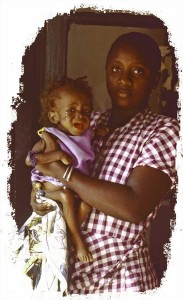 From: Tubob: Two Years in Africa with the Peace Corps
From: Tubob: Two Years in Africa with the Peace Corps
I have so often found that once I make up my mind to do something, or feel as though I should do something, a door opens to show the way. During that week’s Friday Well Baby Clinic, we saw several malnourished children. Two of them were so seriously endangered that Sister Roberts, the head nurse, admitted them to the hospital.
As Sister and I gathered our papers after a long session in which we saw about 350 children, she said, “Mariama,rather than go on trek to the outlying clinics with the team, what would you think about following up with the malnourished children, those we admit to the hospital? Talk to the mothers while they are here at the hospital with their children, then when they’re released, follow up at their villages?”
There it was. My chance. “Talk to them about nutrition? You bet! I’d love to do that. I could also follow up on the ones we see but don’t admit.” My mind whirled with the possibilities.
I had learned from my reading and then later saw for myself the terrible effects of malnutrition. Malnutrition often doesn’t come from poverty–food was usually available in The Gambia–but from lack of education. Two types of malnutrition commonly seen in The Gambia was kwashiorkor and marasmus. The kwashiorkor child eats enough, but it isn’t the right balance of food. For instance, he eats only starchy food. At first glance, he looks fat, but his muscles are thin, his skin dull and hair reddish. I saw a lot of kids who fit that description.
The marasmus child looks very thin, the typical starving-to-death look. This is often seen among those children who have been suddenly weaned. The child balks at regular food, or he gets diarrhea from an abruptly changing diet, weakens and dies.
Breast feeding is the norm in The Gambia. African women have great quantities of milk. Lack of mother’s milk is rarely a problem. Unfortunately they often breast fed exclusively for too long. Breast feeding is a wonderful, sanitary way to feed infants, but local practice was to breast feed until the child was two years old, or until the mother became pregnant, and the child then suddenly weaned. When offered regular food, the child often balked and quickly became malnourished. Unfortunately, this was not an uncommon scenario. The death rate between birth and five years at that time was 50 percent. This was a terrible statistic and the cause of death often avoidable. There were several reasons for a child’s death, but
due to sudden weaning was one of the most common.
I had my work cut out for me.

